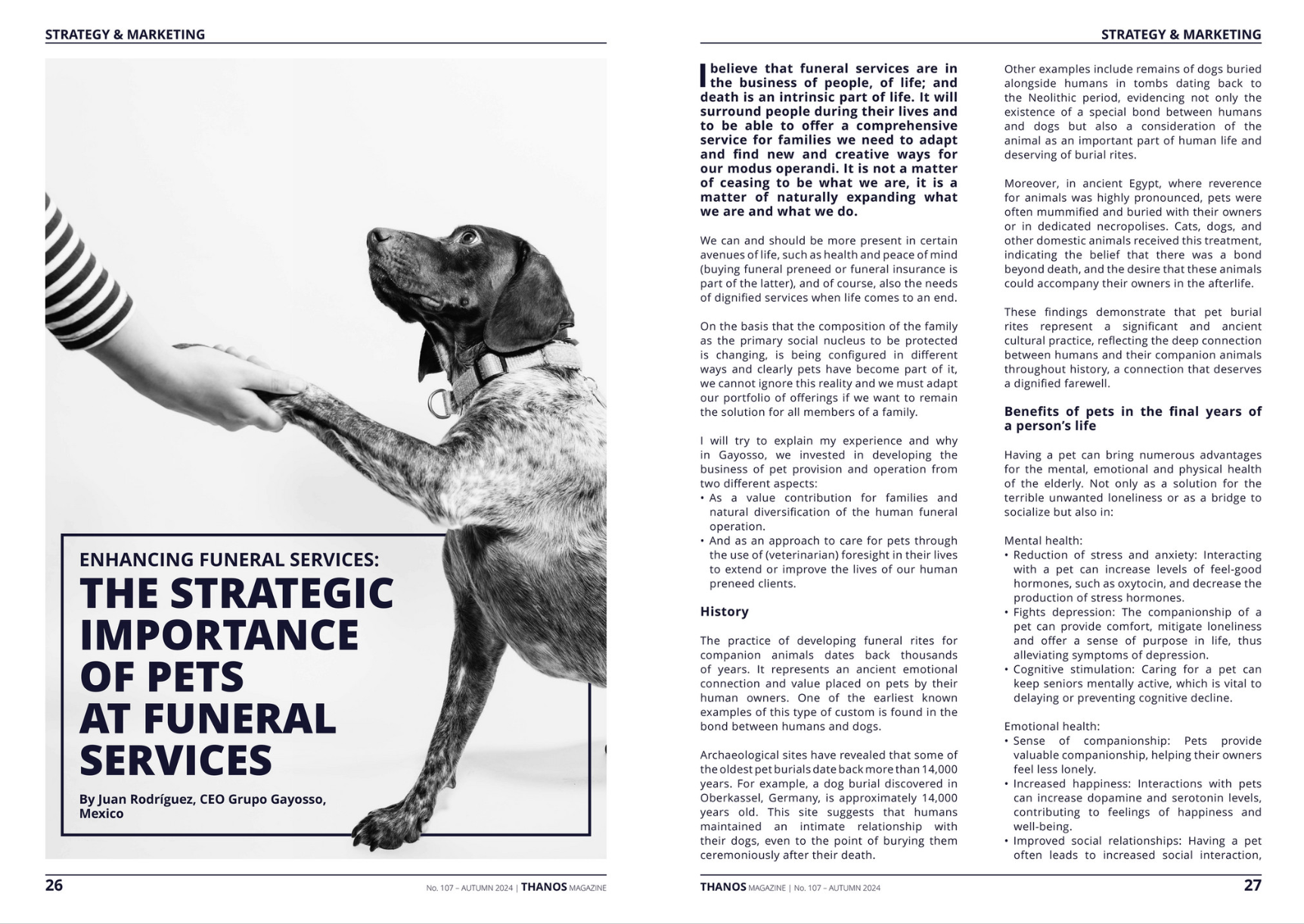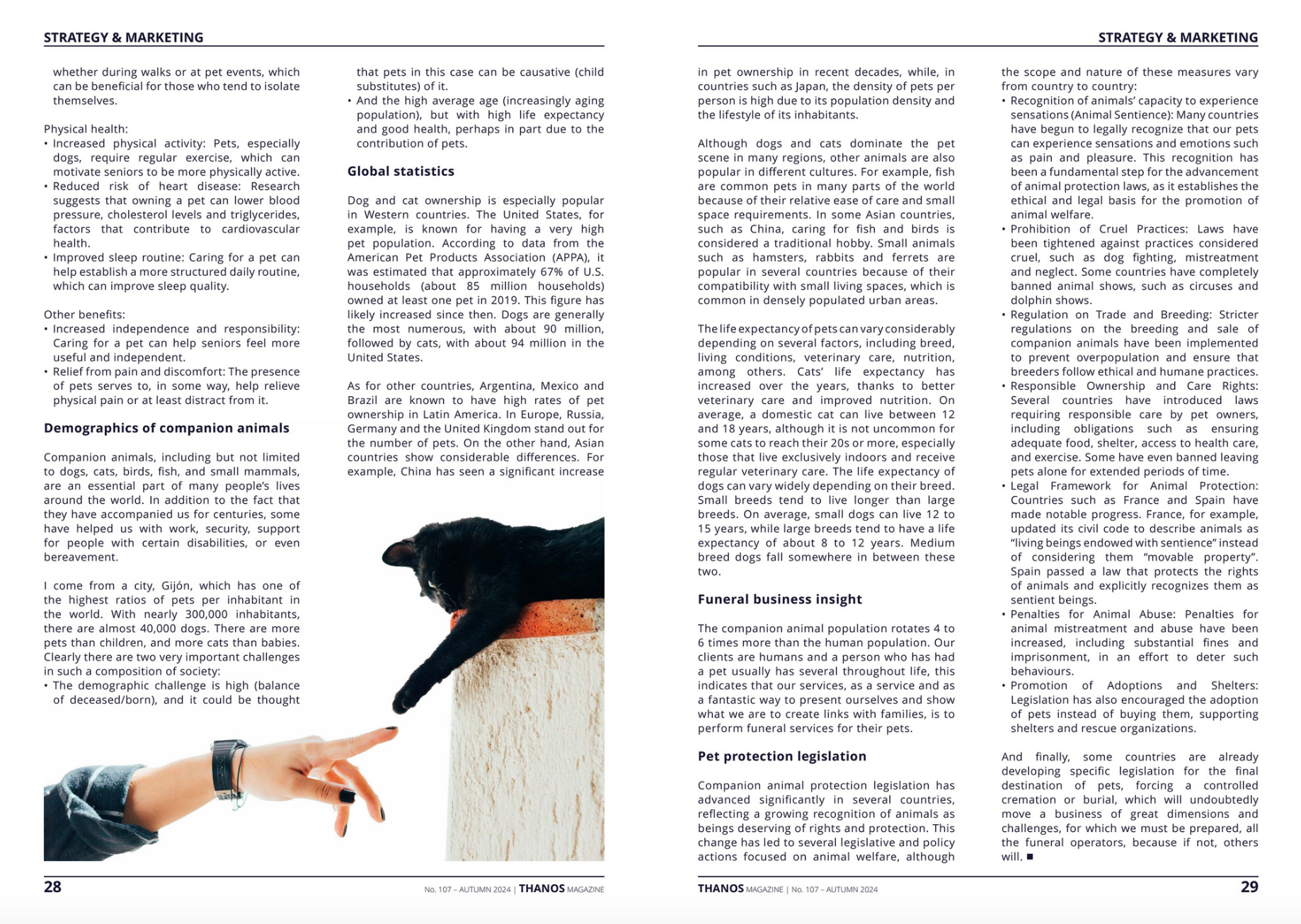«Enhancing funeral services: The strategic importance of pets at funeral services»
Believe that funeral services are in the business of people, of life; and death is an intrinsic part of life. It will surround people during their lives and to be able to offer a comprehensive service for families we need to adapt and find new and creative ways for our modus operandi. It is not a matter of ceasing to be what we are, it is a matter of naturally expanding what we are and what we do.
We can and should be more present in certain avenues of life, such as health and peace of mind (buying funeral preneed or funeral insurance is part of the latter), and of course, also the needs of dignified services when life comes to an end.
On the basis that the composition of the family as the primary social nucleus to be protected is changing, is being configured in different ways and clearly pets have become part of it, we cannot ignore this reality and we must adapt our portfolio of offerings if we want to remain the solution for all members of a family.
I will try to explain my experience and why in Gayosso, we invested in developing the business of pet provision and operation from two different aspects:
As a value contribution for families and natural diversification of the human funeral operation.
And as an approach to care for pets through the use of (veterinarian) foresight in their lives to extend or improve the lives of our human preneed clients.
History
The practice of developing funeral rites for companion animals dates back thousands of years. It represents an ancient emotional connection and value placed on pets by their human owners. One of the earliest known examples of this type of custom is found in the bond between humans and dogs.
Archaeological sites have revealed that some of the oldest pet burials date back more than 14,000 years. For example, a dog burial discovered in Oberkassel, Germany, is approximately 14,000 years old. This site suggests that humans maintained an intimate relationship with their dogs, even to the point of burying them ceremoniously after their death.
Other examples include remains of dogs buried alongside humans in tombs dating back to the Neolithic period, evidencing not only the existence of a special bond between humans and dogs but also a consideration of the animal as an important part of human life and deserving of burial rites.
Moreover, in ancient Egypt, where reverence for animals was highly pronounced, pets were often mummified and buried with their owners or in dedicated necropolises. Cats, dogs, and other domestic animals received this treatment, indicating the belief that there was a bond beyond death, and the desire that these animals could accompany their owners in the afterlife.
These findings demonstrate that pet burial rites represent a significant and ancient cultural practice, reflecting the deep connection between humans and their companion animals throughout history, a connection that deserves a dignified farewell.
Benefits of pets in the final years of a person’s life
Having a pet can bring numerous advantages for the mental, emotional and physical health of the elderly. Not only as a solution for the terrible unwanted loneliness or as a bridge to socialize but also in:
Mental health:
- Reduction of stress and anxiety: Interacting with a pet can increase levels of feel-good hormones, such as oxytocin, and decrease the production of stress hormones.
- Fights depression: The companionship of a pet can provide comfort, mitigate loneliness and offer a sense of purpose in life, thus alleviating symptoms of depression.
- Cognitive stimulation: Caring for a pet can keep seniors mentally active, which is vital to delaying or preventing cognitive decline.
Emotional health:
- Sense of companionship: Pets provide valuable companionship, helping their owners feel less lonely.
- Increased happiness: Interactions with pets can increase dopamine and serotonin levels, contributing to feelings of happiness and well-being.
- Improved social relationships: Having a pet often leads to increased social interaction, whether during walks or at pet events, which can be beneficial for those who tend to isolate themselves.
- Physical health:
Increased physical activity: Pets, especially dogs, require regular exercise, which can motivate seniors to be more physically active. Reduced risk of heart disease: Research suggests that owning a pet can lower blood pressure, cholesterol levels and triglycerides, factors that contribute to cardiovascular health. - Improved sleep routine: Caring for a pet can help establish a more structured daily routine, which can improve sleep quality.
Other benefits:
- Increased independence and responsibility: Caring for a pet can help seniors feel more useful and independent.
- Relief from pain and discomfort: The presence of pets serves to, in some way, help relieve physical pain or at least distract from it.
Demographics of companion animals
Companion animals, including but not limited to dogs, cats, birds, fish, and small mammals, are an essential part of many people’s lives around the world. In addition to the fact that they have accompanied us for centuries, some have helped us with work, security, support for people with certain disabilities, or even bereavement.
I come from a city, Gijón, which has one of the highest ratios of pets per inhabitant in the world. With nearly 300,000 inhabitants, there are almost 40,000 dogs. There are more pets than children, and more cats than babies. Clearly there are two very important challenges in such a composition of society:
The demographic challenge is high (balance of deceased/born), and it could be thought that pets in this case can be causative (child substitutes) of it.
And the high average age (increasingly aging population), but with high life expectancy and good health, perhaps in part due to the contribution of pets.
Global statistics
Dog and cat ownership is especially popular in Western countries. The United States, for example, is known for having a very high pet population. According to data from the American Pet Products Association (APPA), it was estimated that approximately 67% of U.S. households (about 85 million households) owned at least one pet in 2019. This figure has likely increased since then. Dogs are generally the most numerous, with about 90 million, followed by cats, with about 94 million in the United States.
As for other countries, Argentina, Mexico and Brazil are known to have high rates of pet ownership in Latin America. In Europe, Russia, Germany and the United Kingdom stand out for the number of pets. On the other hand, Asian countries show considerable differences. For example, China has seen a significant increase in pet ownership in recent decades, while, in countries such as Japan, the density of pets per person is high due to its population density and the lifestyle of its inhabitants.
Although dogs and cats dominate the pet scene in many regions, other animals are also popular in different cultures. For example, fish are common pets in many parts of the world because of their relative ease of care and small space requirements. In some Asian countries, such as China, caring for fish and birds is considered a traditional hobby. Small animals such as hamsters, rabbits and ferrets are popular in several countries because of their compatibility with small living spaces, which is common in densely populated urban areas.
The life expectancy of pets can vary considerably depending on several factors, including breed, living conditions, veterinary care, nutrition, among others. Cats’ life expectancy has increased over the years, thanks to better veterinary care and improved nutrition. On average, a domestic cat can live between 12 and 18 years, although it is not uncommon for some cats to reach their 20s or more, especially those that live exclusively indoors and receive regular veterinary care. The life expectancy of dogs can vary widely depending on their breed. Small breeds tend to live longer than large breeds. On average, small dogs can live 12 to 15 years, while large breeds tend to have a life expectancy of about 8 to 12 years. Medium breed dogs fall somewhere in between these two.
Funeral business insight
The companion animal population rotates 4 to 6 times more than the human population. Our clients are humans and a person who has had a pet usually has several throughout life, this indicates that our services, as a service and as a fantastic way to present ourselves and show what we are to create links with families, is to perform funeral services for their pets.
Pet protection legislation
Companion animal protection legislation has advanced significantly in several countries, reflecting a growing recognition of animals as beings deserving of rights and protection. This change has led to several legislative and policy actions focused on animal welfare, although the scope and nature of these measures vary from country to country:
- Recognition of animals’ capacity to experience sensations (Animal Sentience): Many countries have begun to legally recognize that our pets can experience sensations and emotions such as pain and pleasure. This recognition has been a fundamental step for the advancement of animal protection laws, as it establishes the ethical and legal basis for the promotion of animal welfare.
- Prohibition of Cruel Practices: Laws have been tightened against practices considered cruel, such as dog fighting, mistreatment and neglect. Some countries have completely banned animal shows, such as circuses and dolphin shows.
- Regulation on Trade and Breeding: Stricter regulations on the breeding and sale of companion animals have been implemented to prevent overpopulation and ensure that breeders follow ethical and humane practices.
- Responsible Ownership and Care Rights: Several countries have introduced laws. requiring responsible care by pet owners, including obligations such as ensuring adequate food, shelter, access to health care, and exercise. Some have even banned leaving pets alone for extended periods of time. Legal Framework for Animal Protection: Countries such as France and Spain have made notable progress. France, for example, updated its civil code to describe animals as «living beings endowed with sentience» instead of considering them «movable property». Spain passed a law that protects the rights of animals and explicitly recognizes them as sentient beings.
- Penalties for Animal Abuse: Penalties for animal mistreatment and abuse have been increased, including substantial fines and imprisonment, in an effort to deter such behaviours.
- Promotion of Adoptions and Shelters: Legislation has also encouraged the adoption of pets instead of buying them, supporting shelters and rescue organizations.
And finally, some countries are already developing specific legislation for the final destination of pets, forcing a controlled cremation or burial, which will undoubtedly move a business of great dimensions and challenges, for which we must be prepared, all the funeral operators, because if not, others will.



 Juan Rodríguez
Juan Rodríguez